updated 4.12.07
MARS - CYDONIA INFORMATION
INCLUDES VIKING AND SURVEYOR PHOTOS AND OPINIONS
NASA'S POLAR LANDER
NOTE: if a page doesn't come up on AOL, try it on Netscape
there seems to be some kind of browser gliches going on
![]()
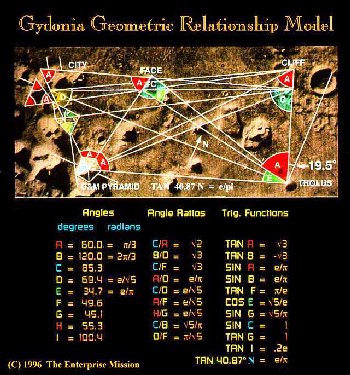
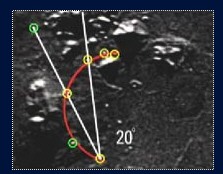
Cydonia Triangles
Click on the link below to watch the video
and see the large photos
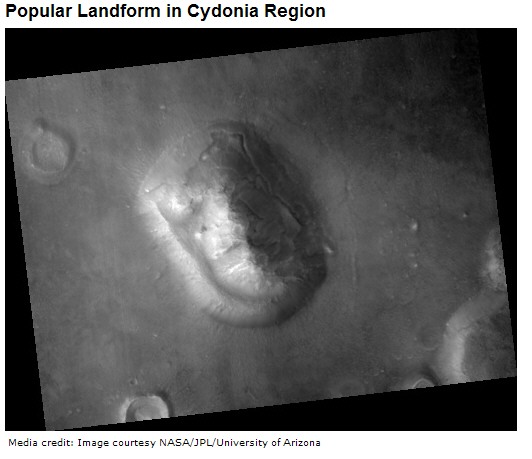
|
||
http://www.coasttocoastam.com/gen/page1256.html?theme=light

Face on old equator: Today, the Face is located at 41° north latitude,
and is tilted from upright (north-oriented) by an angle of 21°.
Prior to the last major pole shift on Mars [P.H. Schultz,
“Polar wandering on Mars', Sci.Amer. 253 (Dec.), pp. 94-102 (1985)],
the Face was located on the Martian equator and oriented upright.
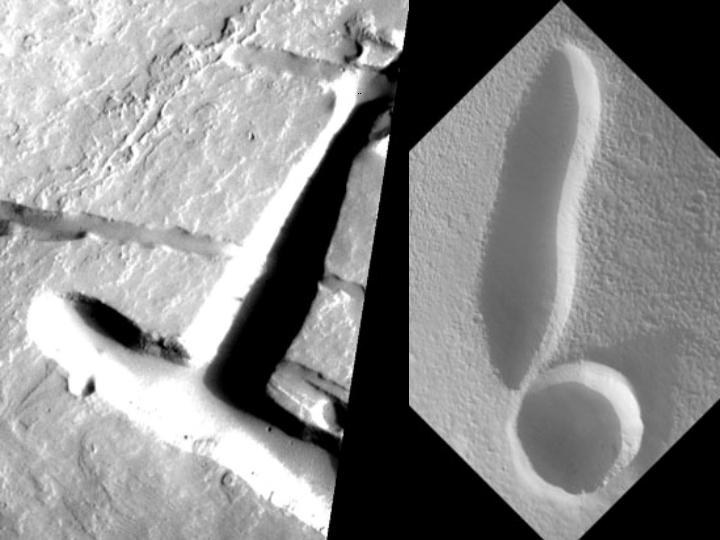
'T'&'': Natural channels rarely end in a
perpendicular 'T'-shape for obvious reasons.
In the image on the right, the
crater appears to have extremely steep walls
and a flat floor. The elongated
shape is incompatible with crater formation
mechanisms because of their
explosive, rather than excavating, nature.
No “source' or “sink' is available
for excavation to have occurred by
flowing liquid. Source for “T': SP243004.jpg.
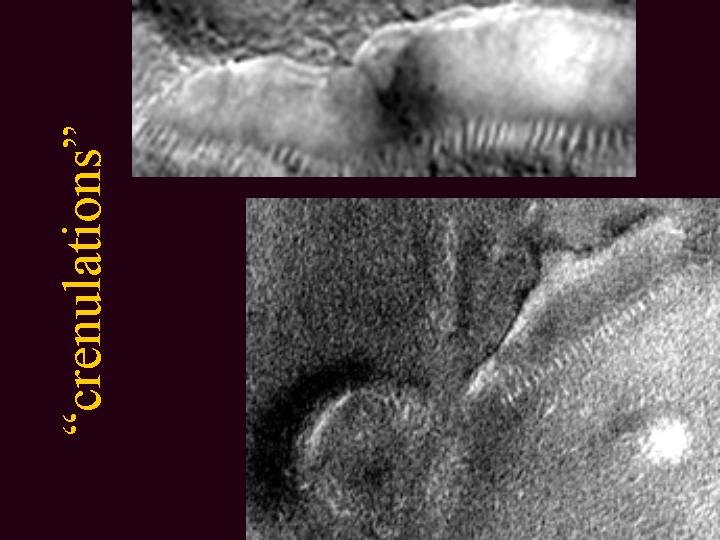
'Crenulations': Rows of parallel white stripes are seen in
numerous locations on Mars.
Often, these lie along the borders of mesas
containing shapes themselves
suggestive of artificiality. The example on the
right shows a hint of the
tube-like structures seen underneath these stripes
wherever the ground is broken.
Sources: M0304566d.gif &

Crenulations are underground tubes: Ground fissures seem
to expose a network
of glassy or translucent underground tubes. The bright spot
might be a specular reflection of the Sun,
consistent with a glassy or plastic
skin. The magnified view shows that the white lines
are bands that appear to
wrap completely around the tubes. Source: M0400291.gif.
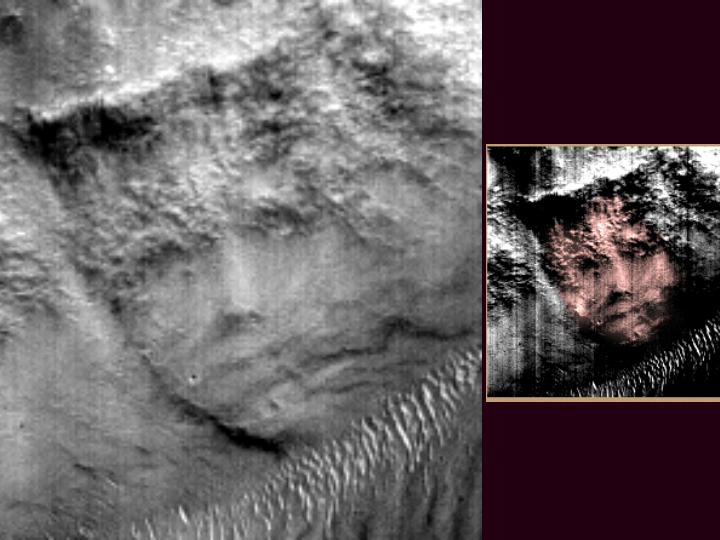
'Crowned face': While not near the Cydonia area, this face
portrayal
is again striking for the richness of its detail, far better than the
typical face arising in clouds or geological formations on Earth.
The latter
tend to be distorted and grotesque when they are more
than simply
impressionistic. Source:M0203051a.gif
Photos and more: See http://www.metaresearch.org/solar%20system/cydonia/asom/artifact_html/default.htm
Cydonia SymbolsFounder of the Cydonia Institute, George Haas and his co-author William Saunders discussed their book, The Cydonia Codex. (Get archive from: http://www.coasttocoastam.com/shows/2005/08/22.html)They believe that the ancient art and sculpture of Mesoamerica is
reflected in geoglyphs of Mars, specifically as depicted in the 2001
'Face on Mars.' Haas suggested that the bifurcated Martian imagery was
like a hieroglyphic writing system, and is evident not only on the Face
but on other structures at Cydonia as well. |
|
|
|
|
|
|
|
|
|
|
|
|
MARS FACE DISAPPEARS?
|
||||
|
||||
9-5-03 - A NEW LOOK AT CYDONIA
A Tale of
Two Cities
1-25-2003 -
RICHARD HOAGLAND IN
SEMINAR Richard Hoagland is looking for some expert photo people to help him out with this project! 9-6-2002 EVER SEE PERFECTLY SQUARE OBJECTS IN THE NATURAL WORLD? CYDONIA CAIRO COMPARISON MINNEAPOLIS, MN COMPARISON I've provided this example as the pages are really busy and not easily accessible!
EnterpriseMission Press Release on Cydonia Themis Analyis (WORD DOC) THE LIGHT FINALLY DAWNS AT CYDONIA WHAT ABOUT THE MARS GLASS TUNNEL ANOMALIES? WHERE ARE SPIRIT AND OPPORTUNITY?
|
ANOTHER PROBLEM ON MARS Scientists: Mars Radiation Dangerous By ANDREW BRIDGES .c The Associated Press PASADENA, Calif. (AP) - Radiation on Mars is so intense that it could endanger astronauts sent to explore the Red Planet, and it's unlikely that any extraterrestrial life would survive there, NASA scientists said. High radiation levels measured by the space agency's unmanned Mars Odyssey spacecraft suggest that any extraterrestrial life would have little chance of surviving unless it were shielded beneath the planet's dusty, cold surface, Cary Zeitlin of the National Space Biomedical Research Institute in Houston said Thursday. ``It would have to be pretty robust against all kinds of environmental horrors,'' said Zeitlin, one of the scientists working on the project. The conclusions stemmed from new data released by scientists at NASA's Jet Propulsion Laboratory from the first year of scientific results from the $300 million mission. Scientists also presented information on the minerals and elements that make up the planet's surface, including measurements that show its northern hemisphere is richer in water than its southern half. Near the planet's north pole, frozen water makes up as much as 75 percent, by volume, of the top 3 feet or so of soil, said William Boynton, one of the mission's scientists. ``We're talking ice with a little bit of dirt mixed in it and not the other way around,'' Boynton said. NASA talks vaguely of future manned missions to Mars, where astronauts could use that ice for drinking water, fuel and oxygen to breathe. The new radiation findings suggest such a mission would be risky. Even so, possible accidents involving the spacecraft that would take astronauts to and from Mars pose a far greater risk, said Robert Zubrin, president of the pro-exploration Mars Society. ``The idea (radiation) represents this incredible, forbidding obstacle to Mars exploration just isn't so,'' Zubrin said. Mars is continuously bombarded by radiation from the galaxy at large, as well as by periodic bursts from the sun. The radiation would expose astronauts in orbit to an effective dose 2.5 times greater than that received by humans in low Earth orbit aboard the international space station, Zeitlin said. A three-year mission would expose astronauts to the radiation limit considered safe by NASA over the career of an astronaut, he added. The radiation environment on the surface of Mars is unknown but probably poses a similar risk, even though the planet's tenuous atmosphere would provide some shielding. ``It still remains to be seen what the hazards are on the surface,'' Odyssey project scientist Jeffrey Plaut said. The main worry for astronauts on Mars would be the periodic bursts of charged particles that stream outward from the sun. On Earth, a global magnetic field and a substantial atmosphere protect against that radiation. Observations made last year show bombardments of solar radiation can last more than a week. Presumably, astronauts on Mars would have to remain confined in some sort of shelter during such blasts of radiation, Zeitlin said. ``They're manageable, as long as the spacecraft has these refuge areas,'' Zeitlin said. Mars Odyssey's science mission is expected to last 1 1/2 more years but probably will be extended. The spacecraft has been thrifty enough with its fuel to enable it to stay in orbit 20 more years, Plaut said. 03/14/03 05:22 EST Copyright 2003 The Associated Press. |
11-1-2002
THE GREAT
DEBATE - CYDONIA
FRANK KNIZE
Image: Mars Face, Nighttime Infrared Subj: No Mars Face at Night Weirdness Date: 11/8/2002 From: ewarrior@electricwarrior.com The Electric Warrior : News November 8, 2002 http://www.electricwarrior.com/ » NO MARS FACE AT NIGHT WEIRDNESS *** A Cydonia researcher says there are no weird thermal anomalies in a nighttime infrared image of the Mars Face. NASA experts say recent data shows the true geological nature of the Martian enigma *** (The Electric Warrior) - Mars anomaly researchers who have been clamoring for a nighttime infrared image of Cydonia got their wish last week just in time for Halloween. An imaging science expert now says there are no thermal anomalies proving an artificial origin for the Face or other well known features at Cydonia. In the new nighttime image the notorious Face on Mars is hard to distinguish from the surrounding terrain unless you know where to look. The Face is circled in the photo that accompanies this blog. Why is it important what the Mars Face looks like at night? Mars anomaly researchers say that a nighttime infrared image might provide clues about whether or not the Face is artificial, proving the presence of extraterrestrial intelligence beyond Earth. But according to Mark Carlotto, whose New Frontiers in Science Web site examines the Martian enigmas, there are no thermal anomalies in the new image that would point to an artificial origin for the Mars Face or the D&M Pyramid of Cydonia. Carlotto goes on to say that if artificial structures had been inactive for a long time he wouldn't expect to see thermal anomalies anyway. "Highly eroded artificial structures that have been inactive for hundreds or thousands of millennia are likely to be in a state of thermal equilibrium with respect to the background. One would therefore not expect to see a thermal anomaly," writes Carlotto. That doesn't mean Carlotto has given up hope for finding evidence of ET on Mars. His "Cydonia Controversy" Web page says that rather than seeking out conspiracy theories and government cover-ups that can't possibly be supported by the data in hand we should simply follow the data to where it leads. Carlotto thinks there are subtle indications of symmetry, geometry, and pattern in the area that are worth studying. He recently uncovered a rock strewn area south of the Mars Face that looks curiously similar to archaeological sites on Earth. The SETI Institute's Dr. Jill Tarter has said that there might be evidence of ET technology within our solar system. Carlotto and others say it's worthwhile looking on Mars. IN THE DARK But according to Arizona State University's Philip Christensen, Cydonia researchers don't like it when NASA releases new images that show the geological nature of the Face. Christensen, who leads the Mars Odyssey thermal imaging team (THEMIS) recently told the Discovery Channel that he gets nasty emails from people accusing him of being part of a cover-up. As reported by Discovery Channel: The only reason NASA still calls it a face is that there are some people who religiously claim that the feature is not natural and will cry "cover-up" if NASA lets the matter drop. At night many of the Martian hills in this region become invisible to the THEMIS camera because there is no heat signature to make them stand out. The Face is much easier to see during the day in a photo shown side-by-side with the new nighttime THEMIS data. The ASU Web site explains, "This knob can be seen in the daytime image because of the temperature differences between the sunlit and shadowed slopes." The online ASU article concludes that recent NASA missions like Mars Global Surveyor and Mars Odyssey have provided detailed views of the hill which show that it is a normal geologic feature. Mars Cydonia researchers awaited the new nighttime image to see whether it revealed anything peculiar. Some won't be happy with either ASU's assessment that the true nature of the Mars Face is geological or Carlotto's analysis that fails to reveal any thermal signature weirdness. Carlotto has said that building a case for artificiality on Mars that even NASA can't dismiss takes time. Electric warriors are content to await further analysis. -------------------------------------------------- RELATED RESOURCES 08-Nov-02 Analysis of First Night-Time IR Image over Cydonia http://newfrontiersinscience.com/cydoniacontroversy/updates/nightIRprelim/nightIR.shtml (New Frontiers in Science) - First night-time image acquired by THEMIS aboard the Mars Odyssey spacecraft shows no evidence of thermal anomalies of artificial origin in the Cydonia region containing the Face, D&M Pyramid and other objects. 06-Nov-02 Face on Mars Gets Nighttime Look http://dsc.discovery.com/news/briefs/20021104/mars.html (Discovery Channel) - The face on Mars has been spotted again, this time in a nighttime infrared image that tells a bit more about its mysterious geological origins... The face itself looks a lot less face-like close-up, of course, and was first called a face because of low-resolution Viking images some 30 years ago. 31-Oct-02 The so-called 'Face on Mars' at night http://themis.asu.edu/zoom-20021031A.html (NASA/ASU) - This pair of THEMIS infrared images shows the so-called "face on Mars" landform viewed during both the day and night. The nighttime THEMIS IR image was acquired on Oct. 24, 2002; the daytime image was originally released on July 24, 2002... The 3-km long 'face' knob was first imaged by the Viking spacecraft in the 1970's... Since that time the Mars Orbiter Camera on the Mars Global Surveyor spacecraft and the THEMIS visible and infrared cameras on Mars Odyssey have provided detailed views of this hill that clearly show that it is a normal geologic feature. 14-Oct-02 Carlotto Finds Possible Ruins on Mars http://www.electricwarrior.com/news/ewNews004A.htm (The Electric Warrior) - A Cydonia researcher says that a rock strewn area south of the Mars face looks curiously similar to archaeological sites on Earth. SETI's Jill Tarter didn't say exactly where we might find evidence of extraterrestrial activity in our own solar system. Carlotto and the Society for Planetary SETI Research say it's worthwhile looking on Mars. This text is freely distributable for non-commercial purposes, provided you cite The Electric Warrior. Web developers should link here... http://www.electricwarrior.com/news/ewNews004C.htm Readers are strongly cautioned that The Electric Warrior asserts it is OK to laugh and have a good time with some of this stuff. Lighten Up! The Electric Warrior is not responsible for the content of Web links. Content reproduced here is for informational purposes only. All copyrights Acknowledged. eWarrior@electricwarrior.com
|
| Russian Space Official: Humans to Mars as Priority
By Leonard David - Senior Space Writer 20 October 2002 HOUSTON -- The Russians are itching to send a human crew to Mars…and are miffed that NASA remains undecided on such an undertaking. A leading expert in human Mars missions, Leonid Gorshkov of RSC Energia in Russia sketched out a reusable Interplanetary Expedition Complex for dispatching a crew to Mars in 2022. Here at the World Space Congress, Gorshkov challenged NASA to move up a humans-to-Mars mission and make it a high priority. Russian complaints A human Mars mission "is a very serious thing," in Russia Gorshkov said, underscoring decades of plans that contain technical solutions to achieve such a goal. Russian space designers have blueprinted a Mars vehicle that would have a lifetime of 15 years and after servicing could be used again. Gorshkov said that "this is the most reliable concept at present." "We believe it has to be an international project. However, we can see that NASA considers an expedition to Mars as one of the lowest priorities. So we end up being in an awkward situation," Gorshkov said. Gorshkov said that they have a simplified, less expensive Mars mission that would have a crew orbit the red planet. Through telerobotics, that expedition would "send their eyes and hands down to Mars," he said. "It’s important for me to convince you that human flight to Mars is a reality," Gorshkov said. "When the wheel was first invented it probably wasn’t extremely useful right away, but it became very useful later," he said
|
New Files From Enterprise Mission
| » THERMAL IMAGE HEATS MARS FACE CONTROVERSY martian enigmas
*** A new infrared image of the notorious Mars Face reveals nothing so much as our fascination with ET ***
photo: Cydonia 2002 - Infrared, Daytime
NASA's high-tech infrared camera recently photographed the Mars Face, along with other controversial landforms in the Cydonia region. As usual, the new photo inspires speculation about the search for extraterrestrial intelligence. The Thermal Emission Imaging System (THEMIS) on board the Odyssey spacecraft captured an excellent regional view of Cydonia. NASA's point of view is that the Mars Face is just one of many normal geologic features, all eroded into a remarkable array of different shapes: "The Cydonia region is seen to be covered with dozens of interesting knobs and mesas that are similar in many ways to the knob named the 'face'," says the THEMIS image caption. NASA's new Cydonia photo is different because unlike an ordinary camera, THEMIS shows temperature effects. Hot spots are "white", cool spots are "black", and since it was taken during daylight, the temperature effects are those caused by ordinary sunlight. As a result, the image looks remarkably similar to the historic Viking images that started the Mars Face controversy. According to the Cydonian Imperative, an online blog dedicated to the Martian enigmas, the infrared image tells us nothing new or unexpected. "While the IR image is a welcome contribution to the study of the Cydonia region, it provides no evidence confirming or refuting the Artificiality Hypothesis," writes Mac Tonnies Tonnies thinks what we really need is an infrared image that shows us heat signatures at night. "A night-time IR image is needed to help test the notion that the Face and D&M Pyramid are (at least partially) hollow, and thus almost certainly non-natural. Landforms, natural and otherwise, radiate heat in distinct ways. " Richard Hoagland, the foremost expert on the Mars Face, thinks there is a great deal more to the release of the latest THEMIS image. Hoagland tells us his sources hint that a night-time image has already been taken, and NASA is hard-pressed to explain it. As Hoagland has it, there is a conflict within our government over the question of extraterrestrial artifacts on Mars. "Some inside NASA still apparently have not gotten 'the word' that there’s a 'new day dawning' around this issue, and increasing 'disclosure' is supposed to be the policy from now on." REASON TO BELIEVE Cydonia researchers have argued that if the search for extraterrestrial radio signals is legitimate science, then why not the search for extraterrestrial artifacts? In a surprising reversal of policy, the SETI Institute's Dr. Jill Tarter recently told Space.com that evidence of extraterrestrial activity might be present in our own solar system. "It's possible that there could be, in fact, within our solar system, some evidence of ET technology," said Dr. Tarter, the woman upon whom Jodie Foster's character in the movie "Contact" was largely based. "They may be here." Is the Face evidence of alien visitation, or the remnant of a lost civilization on Mars? Either way, and in spite of the fact that it looks less like a human face as our technology improves, the notorious hill in Cydonia somehow prompts us to ask whether mankind is truly alone. But if additional information from NASA's Odyssey shows up, don't expect it to be conclusive. Not unless you've already made your mind up one way or the other. In that case, you don't need any more information, beyond confirming your own beliefs. Empirical science doesn't work that way. Our biggest challenge as human beings will be to see what is really there, and accept it for what it is, not what we suppose it to be. If science is beginning to warm up to the notion of the Search for Extraterrestrial Visitation (SETV), then perhaps its time for Cydonia enthusiasts to cast aside elaborate conspiratorial mythologies that demonize anyone who disagrees with them. Apriori conclusions on either side of the argument hinder legitimate inquiry. "Electric Warriors", at least, still need a reason to believe. -------------------------------------------------- RELATED RESOURCES
24-Jul-02 (THEMIS Science Team) - In this "big picture" view the Cydonia region is seen to be covered with dozens of interesting knobs and mesas that are similar in many ways to the knob named the "face" - so many in fact that it requires care to discover the "face" among this jumble of knobs and hills. The 3-km long "face" knob was first imaged by the Viking spacecraft in the 1970's and was seen by some to resemble a face carved into the rocks of Mars.
24-Jul-02 (The Cydonian Imperative) - If the Face is hollow and/or composed of materials other than native rock, we should expect to find a thermal emission "signature" telling us as much.
23-Jul-02 (Enterprise Mission) - According to our separate "Bush Administration" source, the image we are supposed to be getting is a "nighttime Cydonia IR image" – where the accumulated heat of the day is slowly radiating back into space throughout the night. On this image, we've been told, certain features will "stand out as almost unmistakably different." |
WATER AND NEW STUFF ON MARS NEVER KNOWN BEFORE
4-23-2002 - THE FOUR HORSEMEN OF THE APOCALYPSE
4-17-2002 - INCREDIBLE NEW ARTICLE AND PICTURES OF MARS
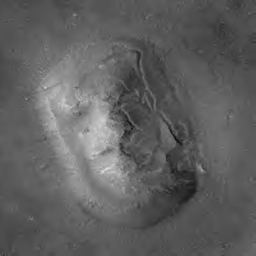
2002 IMAGE FROM 'ODYSSEY'
4-17-2002 - A WHOLE NEW MARS - THE CHAOS REGION
at enterprisemission.com
Mars Odyssey Ready to Tackle Science Agenda By Leonard David Senior Space Writer posted: 07:00 am ET 21 January 2002 RENO, NEVADA – NASA’s Mars Odyssey is ready to start science duties as it circles the Red Planet. The spacecraft completed a set of aerobraking maneuvers January 11 following weeks of dipping in and out of Mars’ thin atmosphere in order to tighten its orbit around the planet. An upcoming and key event is deployment of Odyssey’s high-gain antenna. That equipment is crucial in relaying to Earth quantities of data to be gleaned by the spacecraft’s science instruments. The antenna is to be released and deployed with a motor-driven hinge. Release of the high-gain antenna is to occur after a final adjustment of Odyssey’s orbit takes place. That small adjustment is tagged an "orbit freeze" maneuver. This tweaking of Odyssey’s orbit is being done to avoid the remote chance it could smack into another orbiting spacecraft – the Mars Global Surveyor. Serve up surprises Steve Saunders, project scientist for the 2001 Mars Odyssey mission, expects the probe will serve up surprises in regards to its main agenda – spotting the signature of water on the reddish globe. "The spacecraft has been working extremely well. That is what the engineers are saying. My assessment is that they’ve been performing extremely well in flying Mars Odyssey," Saunders told SPACE.com during the 40th American Institute of Aeronautics & Astronautics (AIAA) Aerospace Sciences meeting held here last week. Saunders said the Thermal Emission Imaging System (THEMIS) aboard Odyssey "looks like it’s working great," and is ready to start operations. THEMIS is designed to determine the distribution of minerals, particularly those that can only form in the presence of water. Once the high-gain antenna is deployed, all is in ready for THEMIS to start pumping to Earth volumes of data, he said. THEMIS was tested shortly after the Mars Odyssey was launched in April 2001. The instrument was also briefly used during aerobraking maneuvers. Another instrument, the Gamma Ray Spectrometer (GRS) is on tap to begin its task of determining the presence of 20 chemical elements on the surface of Mars. The GRS can scan for hydrogen in the shallow subsurface, thereby ascertaining the amount and distribution of possible water ice on the planet. Early targets During the first month or six weeks of science operation at Mars, Odyssey is to start looking at high-priority targets, Saunders said. Potential landing areas for NASA’s 2003 Mars Exploration Rovers are to be viewed. "We’ve got a number of other high-priority targets that are of great interest to people in general," Saunders said. Those include the top of Olympus Mons, Valles Marineris, and the so-called "Face on Mars" – a site that some claim to be of artificial nature. "We’re going to try to cover all that in the first month or so, and release the data immediately…and just get it out there," Saunders told SPACE.com. "There’s always a sense, true or not, that we’re not getting it [data] out fast enough. It’s not always the fault of any particular investigator or mission. It just has to do with planning and money," Saunders said. "We’re going to try and solve that by giving out what may be the most interesting stuff in general as soon as we can," he said. End of year results By year’s end, Mars Odyssey is likely to have painted a good picture regarding the distribution of near surface hydrogen on Mars using a suite of sensors. "I think we should have a pretty good picture of the high latitude regions in terms of their chemical composition. We won’t have sampled enough around the equator, but we should have a pretty good picture what the polar regions look like. We’ll have a whole bunch of nice images from THEMIS…and by then we should have done the analysis of some areas to come up with some interesting deposits on Mars," Saunders said. "We always get a lot of surprises, especially when we do a huge jump in resolution as we do with THEMIS," Saunders said. "So I think we’ll see some things that we didn’t expect." Odyssey’s primary science mission is slated to continue through July 2004. During and after its science mission, the Odyssey orbiter will also support other missions in NASA’s Mars Exploration program. It will provide the communications relay for U.S. and international landers, including the next mission in the space agency’s Mars Program, the Mars Exploration Rovers to be launched in 2003. Scientists and engineers will also use Odyssey data to identify potential landing spots for future Mars missions. http://www.space.com/missionlaunches/odyssey_update_020121.html |
8/13/01 - Martian Life Revisited -- Do the "Tides of Mars" Make This More Viable?
8/06/01 - More Confirmation of Finnish Anti-Gravity Experiments
7/24/01 - A Geologist's View of the "Martian Grid"
7/16/01 - How to Make a "Mountain" Out of a MOL(A) Hill
7/14/01 - Mirror, Mirror ...
7/14/01 - The Great Sphinx of Mars?
7/10/01 - Apollo Hoax Advocates Look -- But They Don't "C"
7/05/01 - New Conference Area Opened
6/22/01 - The Great 2001 Mars Flare Search
6/20/01 - Artistic Interpretation of the Face
6/20/01 - An Engineering Analysis of the Face on Mars
FRESH IMAGES FROM MARS - SHADOW SIDE OF THE FACE REVEALED
5-26-2001
|
The 1976 image is on the left. Image from 2001 on the right. Compare to those posted below in 1999 Other comparisons listed below |
http://www.msss.com/mars_images/moc/extended_may2001/face/index.html
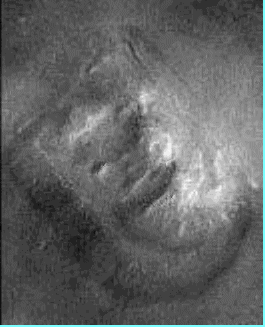 |
 |
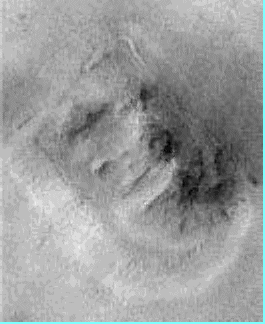 |
NEW FACE #1 |
ORIGINAL MARS FACE |
NEW FACE INVERTED |
Judge for yourself if this is the same face
The face on the right is inverted like a negative to show similar lighting to the original
| The Electric Warrior : News May 20, 2001
http://www.electricwarrior.com/news/ewNews0023.htm NASA RESPONDS TO FACE ON MARS INQUIRY From: Peter Gersten Citizens Against UFO Secrecy (CAUS) NASA has responded to our March 16th letter on behalf of FACETS. In its 3-page letter, NASA denies that any images of Cydonia have been withheld and astonishingly states that it has re-imaged the region pursuant to our request. The letter contains some startling statements as well as inviting FACETS to submit a specific list of requests for targeting additional area of Mars. ------------------------------------------------------------
National Aeronautics and Space Administration May 11, 2001
Mr. Peter A. Gersten Dear Mr. Gersten: In response to your letter to NASA Administrator Daniel S. Goldin dated March 16, 2001, from the Formal Action Committee for Extra-Terrestrial Studies (FACETS), NASA has fully and openly distributed by means of public web-sites all images obtained of the Cydonia “face” feature under question. To date, more than 90,000 images of Mars have been acquired by the Mars Global Surveyor (MGS) Mars Orbiter Camera (MOC), as well as hundreds of millions of laser altimeter topographic measurements and infrared spectra. None of the images acquired to date by the MGS/MOC system have been withheld and indeed, several recently (April 8, 2001) acquired images, including stereoscopic coverage of the Cydonia feature under question, have been released via multiple public web sites. In this case, NASA responded to the request by FACETS (presented in the letter by Peter Gersten to Mr. Goldin on March 16, 2001) by initiating a complex set of MGS spacecraft operations to ensure that the highest possible resolution images of the Cydonia “face” feature were acquired. These spacecraft operations require special care and only a few can be performed each day. In addition to 1.5 m per pixel (about 5 foot resolution) resolution images of the Cydonia feature, NASA released a stereo 'anaglyph' of the feature that allows a viewer with colored ''3D” glasses to view the feature in 3D. This is the first release of a 3D image of any features on Mars acquired in this resolution. Furthermore, NASA has assembled public web site access of ALL MGS images acquired of the Cydonia Face feature since the start of MGS scientific observations. Given the challenges of imaging any feature on Mars (ie., NASA has yet to “find” the second Viking Lander specifically), this has involved considerable effort. The newly released Cydonia observations reveal an intriguing mesa-like feature not unlike those found in the Southwestern USA, with geologic features than can be attributed to processes in multiple places on Mars in which isolated topographic features (remnants) have been observed. NASA encourages the development of multiple working hypothesis models for the formation of such features and in this case the new observations have been publicly released to permit further debate about controversial and enigmatic landforms on Mars. Dr. Michael Malin, the Principal Investigator of the MGS Mars Orbiter Camera, has provided his experienced interpretation of the new images, but NASA welcomes additional opinions. Indeed, NASA promotes innovative analysis of such spacecraft data by competitive peer-review, as well as via open discussion in public meetings and by all members of the interested-public. In the letter to Mr. Goldin by the members of FACETS, there are statements that are not consistent with published (and hence peer-reviewed) results from scientific literature. NASA does not know of any statements by Sir Arthur C. Clarke that suggest “…pretty convincing proof of the existence of large forms of like on Mars,” nor are there any in the extant, peer- reviewed literature. NASA favors exploring the Universe for evidence of biological processes and aspects of the newly restructured Mars Exploration Program support a variety of approaches for searching for evidence of biological processes on Mars. NASA has responded to the requests of the FACETS group in exactly the fashion requested in the March 16 letter, by targeting the Cydonia feature under question will (sic) the highest possible resolution, and most optimized illumination, as well as in stereo, to make available observations to the general public in a responsive manner. These data are released and available for interpretation by the FACETS members. They were so recently acquired from the MGS that there may have appeared to have been a delay in their release, but this was not the case. When an image is acquired at Mars it must be relayed to Earth via a specific process and then reconstructed on the ground before it can be posted on a public web site. This was accomplished at the end of last week (by April 19), and the data released on that date. Thus on the basis of the requests made in the March 16 letter addressed to Mr. Goldin by Peter Gersten, the following items have been met or exceeded as follows: (1) all images of the Cydonia area have been released on the internet (via www.msss.com and other public NASA sites via JPL) (2) stereoscopic, full resolution (1.5 m/pixel) MOC images were acquired at optimized illumination conditions of the Cydonia features and have been released via the internet (3) NASA awaits a specific list of requests for targeting the “…five additional areas of Mars from a list submitted by FACETS,” but no such list has yet been received. NASA welcomes a variety of opinions about the origin of the enigmatic features on Mars as observed by the instruments aboard the Mars Global Surveyor. NASA relies upon the peer- review process and competitive peer review to fund analysis of the data it acquires and awaits newly published (or proposals to undertake such) interpretations of the Cydonia “face” feature. At present the Scientific advisory committees that formally advise NASA have not interpreted the Cydonia feature as evidence of extraterrestrial intelligence. NASA will continue to explore all possibilities for the origin of landscapes on Mars using the open process it has traditionally utilized, as well as by timely release of all images acquired by operational spacecraft, including the MGS. NASA thanks the members of FACETS for their continuing interest in the Cydonia region and welcomes additional comments. Sincerely,
Edward J. Weiler ------------------------------------------------------------ RELATED RESOURCES » EW Web Site Posts Mars Face Demand Letter FACETS, a space exploration activist group which released a statement last April, made the full text of the letter to Daniel Goldin available. http://www.electricwarrior.com/news/ewNews0016.htm ------------------------------------------------------------ THE ELECTRIC WARRIOR May 20, 2001 Silicon Valley, CA http://www.electricwarrior.com Permission is granted to reproduce or redistribute this article or any portion thereof, provided The Electric Warrior is cited as the source. Images are created exclusively for the Electric Warrior Website. They can be downloaded and cached for individual use, but may not be reproduced or used in any other context without permission. eWarrior@electricwarrior.com |
3-20-01 - Spy Agency May Have Located Mars Polar Lander
2-15-01 - The Heart On Mars
2-1-01 - This is the same face? Who are they Trying to Kid?
6-22-00 - Where's
a Good Plumber When you Need One?
Water on Mars - 20 years after the Fact
6-22-00 - Jeff
Rense from Sightings.com interviews
Steven Kurick, Monica Ricks-Paxon, John Brandenburg
Subject: Water on Mars
Wrote the book - Dead Mars/Dying Earth
Real Audio Interview
6-21-00 - Vince DiPietro - Mars Water Spouts
6-8-00 - Photos of Mars anomalies on Richard Hoagland's site.
NOTE: If the photos
don't come up on AOL, try again with Netscape. http://www.enterprisemission.com/samp4.htm Especially interesting are the glass tunnels: http://www.enterprisemission.com/samp5.htm
This image, M04-00291 (found by Hoagland) is certainly the most extraordinary.
Located in an ancient ocean bed which has rifted apart due to some sort of
cataclysmic stress are nothing less than a series of interlocking, reinforced
and still intact translucent, glass-like tubes! |
5-23-00 - NASA
FIND BIGGER OPEN DRAWER OF PHOTOS
NEWS!!! Great Britain is going to send a probe to Mars in 2003
5-17-00 - WHAT COLOR IS MARS SKY? - SEE THESE PHOTOS
4-27-00 - Mars - The Cydonian Imperative On Recent Conspiracy Theories
4-27-00 - THE ASTRONAUTS
-
4-25-00 - following the news of the Shuttle Atlantis
Terraforming Mars
4/11/00 - The Martian Domes....
4-11-00 - Recently Released MGS Images of Cydonia
4/11/00 - First New Goodies From Mars Surveyor of Cydonia ...
4/04/00 - NASA Administrator Reveals Former "Black Ops" NSA Chief in Charge of "Oversight" re JPL!
2-14-00 Mars Global Surveyor Mars Orbiter Camera (MOC)
1-26-00 - NASA'S POLAR LANDER NEWS
PLANETARY ANOMALIES -
THE MARS/MOON/ANCIENT
SITES CONNECTIONS
The Pyramids of Egypt and Mars
marsnt3.jpl.nasa.gov/education/
Pasadena Center: planetary.org
Searching for the Mars-Earth Connection
Mars Surface Anomaly Analysis Group (MSAA)
5-6-98 - NEW PHOTOS FROM CYDONIA
CSETI - CONTACT YOUR CONGRESSMAN ASK FOR OPEN HEARINGS ON UFO SIGHTINGS AND THE ET PHENOMENON LINKS TO ALL THE CONGRESSMAN HERE |
NASA OBSERVATIONS #3 - 4-24-98
APRIL 15TH. ASTRONOMER EXPERT SAYS THAT THE CYDONIA CITY
IS ARTIFICIAL - CHANCE IS 1 BILLION TO 1
MC DANIEL REPORT ON CYDONIA CITY
![]()
PROOF OF
CYDONIA IMAGE TAMPERING
IF THE ABOVE LINK DOESN'T WORK ON AOL, USE NETSCAPE

NEW DISTURBING DATA FROM NASA- EVIDENCE OF A COVERUP?
PRIVATE GROUP GOING TO MARS TO TAKE PICTURES
****************************
GEOMORPHOLOGY OF CYDONIA - MARS FACE
MARS GLOBAL SURVEYOR - SCHEDULE AND PHOTOS
LATEST INFORMATION ON PLANNED TARGETED OBSERVATIONS
MARS GLOBAL SURVEYOR MIRROR SITE LINKS
![]()
MARS/EARTH SIZE COMPARISON AND OTHER INFO
OTHER MARS LINKS